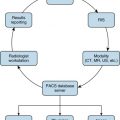Abstract
Leadership training has become a very important set of nonclinical skills for radiologists. However, formal leadership training is not included in the medical school or residency and fellowship training years for many (if not most) physicians. Instead, it is something that must be acquired in addition to medical training. Although there is an active academic debate about the role of nature and nurture in leadership success, there is no doubt that most people can learn leadership skills and improve their chances of succeeding in the role of being a leader. Teaching leadership is often seen as a difficult and even murky endeavor. A helpful approach to handling this issue is to break leadership down into a set of knowledge domains and skills that can be taught. If we analyze what leaders do, then it is easier to develop a curriculum for budding leaders. This can be taught in a variety of formats from full time in residence schools to online, asynchronous, and part-time programs. Leadership is not only a good thing for physicians to learn but it may also have an enormous, even existential impact on our future. The choice is to lead or to be led.
Keywords
Future of radiology, knowledge domains, leadership development, leadership education, leadership skills
Introduction
Historically, to be successful in their professional careers, radiologists must train intensively for years. They must master a daunting amount of clinical material, pass comprehensive tests, and meet a wide array of challenges in their training. That has not changed during my own career (now around a quarter-century in length) and, if anything, the amount of material that radiologists are expected to master keeps increasing as we develop new technologies and new clinical discoveries are made. In this book, you have read about the other critical nonclinical topics that you need to master in addition to all that you have already done on the clinical side. When we consider the list of things that radiologists and other physicians need to know to be successful that are not taught in a traditional medical school curriculum or during postgraduate training, it is unfortunately a daunting list of important topics. It is always surprising to some, particularly those who are outside the medical field, that these subjects are often absent in any serious form in internship, residency, or even in a fellowship curriculum. You should not need to wait until you are in your first or second real job to begin leadership training. These topics are so numerous and so important that a book like this is indispensable for all of us who are hoping to have a successful career in diagnostic radiology in the 21st century.
This chapter focuses on leadership and the role that it should play in the careers of radiologists and why and how you should pursue it. What radiologists need to know to lead is discussed, as well as the ways they can obtain this information. The ability to lead is one of the core nonclinical skills that usually distinguishes highly successful physicians from the rest of us. However, leadership skills are not and should not be limited to those in positions of alpha leadership. On the other hand, do not assume (because it is manifestly not the case) that all leaders in radiology have these capabilities and skills today. Unfortunately, not everyone who carries the title of leader in medicine is effective or even competent in that role. This chapter focuses on the essential skill sets that most of us, perhaps all of us, should have. Being able to lead will allow you to accomplish more in your career, regardless of whether you ever take on a significant leadership role.
Leadership: Myth and Reality in the Nature-Versus-Nurture Debate
One of the obstacles to effective nonclinical education in radiology, and in medicine more broadly, is the misguided notion that skills like leadership cannot be taught. If you take the nihilistic view that leadership is not something that you can learn, then the idea follows that there is no point in teaching it or any point in expecting people to get leadership training. Instead of teaching physicians the leadership skills they need to excel in institutions, they are instead not taught anything or are merely taught how to function in an institution where others are the leaders and the physicians are the followers. The latter approach often devolves into a reductionist set of nonclinical things that someone thinks physicians should know but that do not help that radiologist understand how they might lead a group themselves. These nonleadership courses do not even give a physician the skills to lead at the level of a small group, let alone at the level of a department or hospital. That is not leadership training nor does it provide the building blocks to take even baby steps toward becoming proficient at leadership.
This misguided notion usually springs from the idea that leaders are made (or not made) long before their professional career begins and that leadership training during your career is therefore a waste of time. This is a deterministic view; apparently, your genes or your family interactions and/or upbringing determine your ability to be a leader. Furthermore, it falsely assumes that there are good tests of leadership potential. Much of the genuine value of a leader is proven by him or her in the moment, and although some people can be weeded out of leadership tracks, it is much harder to predict decades in advance who will be a great leader when the big challenges come. I strongly disagree with the myth of being born to leadership, and in my own work at Wharton and elsewhere I have, in fact, seen many examples of midcareer nonleaders turning (with the right training and mentorship and opportunities) into great leaders. In this chapter, I discuss what you can do to acquire these important nonclinical skills. However, I would like to provide a bit more information before closing this argument so that you have a clearer perspective on this debate. Although that could be a chapter unto itself, there are two important caveats that I provide that can help answer the naysayers, perhaps give you a broader perspective on how to think about leaders and leadership, and help you get over your own doubts and concerns about seeking leadership training. The first caveat is that acquiring basic or even core leadership skills does not mean that you will then be ready to be an alpha leader on the scale of a chief executive officer of a Fortune 500 company, the US president, or perhaps the Pope or a powerful admiral in the navy ( Fig. 28.1 ). Those rarefied positions require abilities that are much more advanced and far more specialized than what is available in general leadership training. Moreover, they require both highly specialized and often lengthy life experiences in addition to any other formal training and requirements for someone to be successful. So in that case, the people who are skeptical about the effectiveness of leadership education are technically correct when it comes to certain positions like those just noted. Leadership courses cannot prepare you for every type of leadership position.











